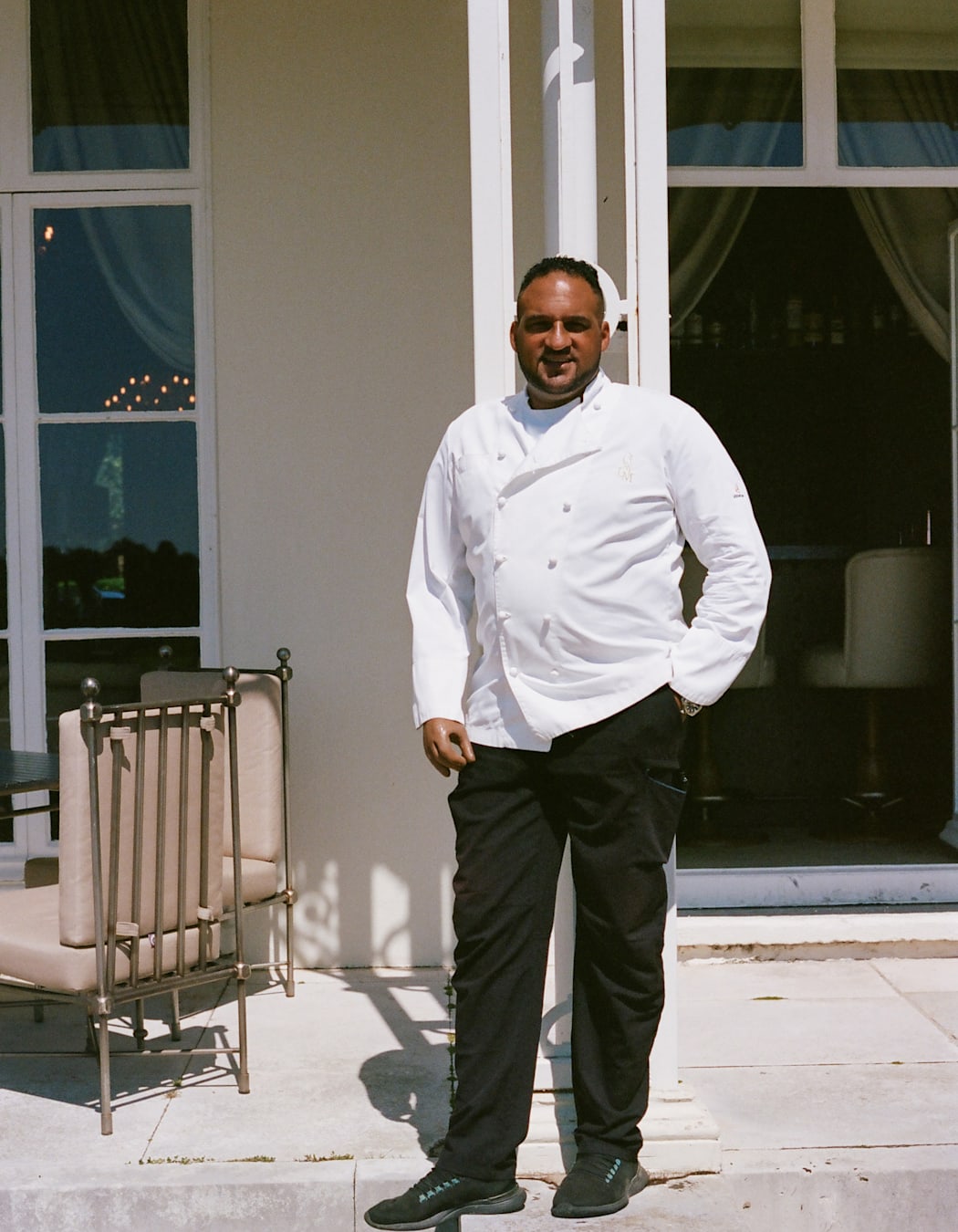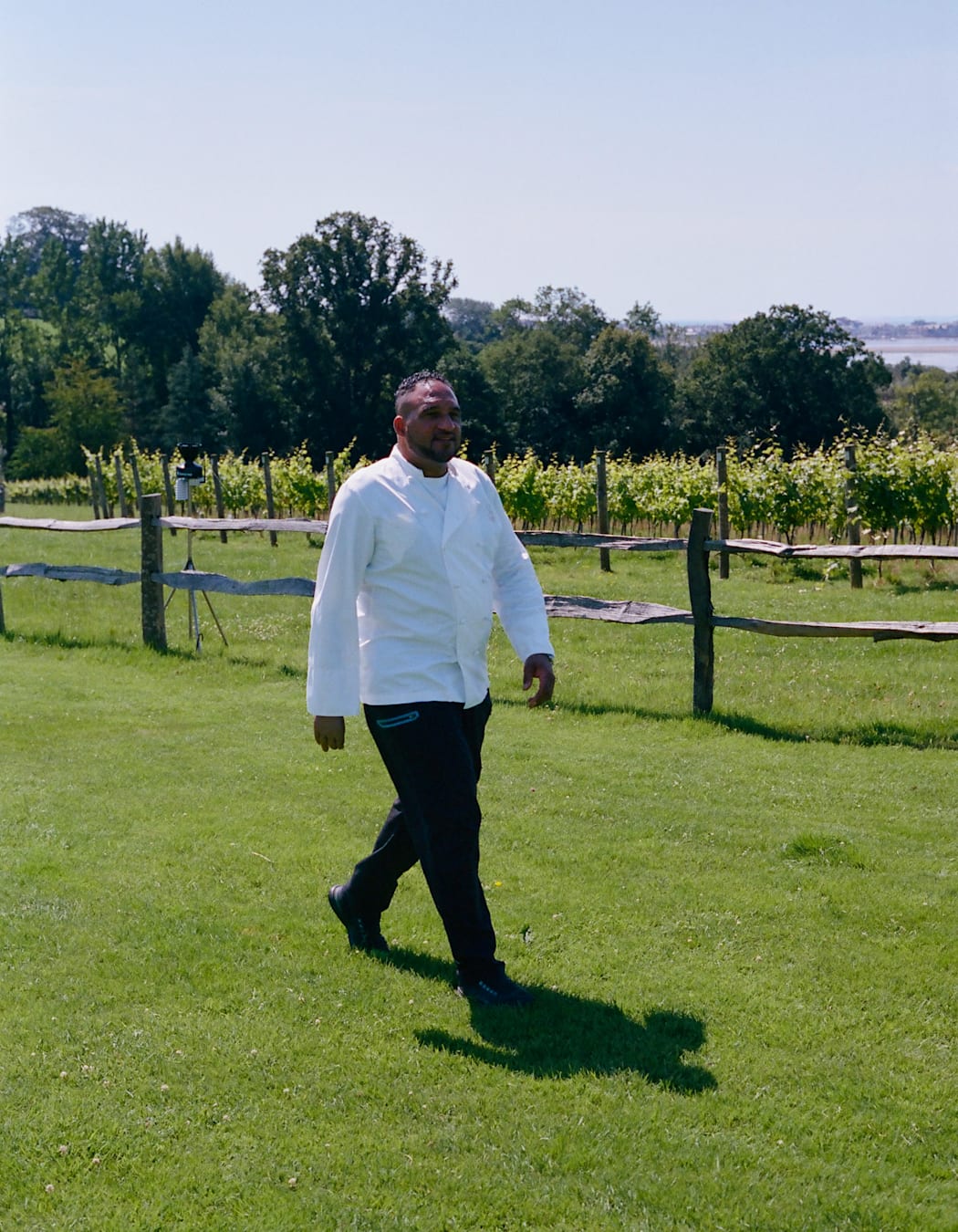Let us introduce you to the world’s most exciting hotel chefs as we guide you through the gourmet getaway spots we’re hungering for…
WHO’S IN THE KITCHEN
Michael Caines’ achievements are as lengthy and impressive as his tasting menus. The Exeter native has collected AA Rosettes, Michelin stars and ‘best chef’ accolades since his first posting at Raymond Blanc’s Le Manoir aux Quat’Saisons. And he wears more hats than just a toque: running hotels, supporting many charities, setting up an academy for budding chefs, and working as an activist and consultant.
WHAT’S COOKING?
Caines is an advocate for local, seasonal, sustainable cookery. His food might be informed by his travels, but at heart it’s proudly Devonian, showcasing the landscape in simple Brit dishes, such as Poached Creedy Carver chicken with Wye Valley asparagus or Powderham lamb with wild garlic.

RECIPE FOR SUCCESS
He’s been head chef at Gidleigh Park hotel, developed the Royal Clarence Hotel and ABode Hotels concept, acted as executive chef for the Bath Priory, catered for the Williams Formula 1 team, and opened the acclaimed Lympstone Manor.
He overcame the amputation of his right arm due to a car accident. He’s cooked for VIPs; made many appearances on MasterChef, The Great British Menu, Sunday Brunch and more; and was awarded an MBE, the freeman of the City of Exeter and the Deputy Lieutenant to the Lord Lieutenant of Devon. And he still has more on the back-burner…
As a chef and hotelier, what makes a great hospitality experience?
The people we engage with, the warmth of our staff and their pride in delivering an exceptional product. I have a beautiful property [Lympstone Manor], but if the staff aren’t passionate, then the guest experience will be inadequate. Even spectacular houses can lack warmth; we want people to feel like they’re home from home. We don’t want to have overbearing service, we want the balance just right. Our staff are key to that; what we do is focused on excellence. Great hospitality is all in the details.
Which culinary venture would you like to try next?
I have a 10-year plan for Lympstone, which includes adding a small spa, more bedrooms and a larger dining room overlooking the estuary. I’d also like to do more consultancies and develop a restaurant in another hotel. I understand both hotels and restaurants well, and the food and drink offering can be misunderstood. Hotel eateries need people to dine in and to attract guests who’ll pay a certain amount for the room and food — it’s about the holistic experience.
Quality can be defined by winning awards, but a talented team needs a focus and challenges to train and develop, and to inspire them to want to give excellent service. I believe I’m a good teacher and have experience to lend to something in the future, beyond Lympstone.
How do you go about sourcing ingredients — are you a forager?
You can forage, but there’s a reason why we mass produce things. When you ravage people’s property, effectively — if you’re picking wild garlic, for example — you affect nature. We cultivate a balance because it can be unsustainable. We forage if we have the opportunity, but also work with farmers and our supply chain to grow things we’d want to forage. These plants are wild but can be cultivated — ultimately we want a closeness between nature and our culinary offering.
You’re a proud Devonian — where do you like to eat when you’re in the county?
I like Mickey’s Beach Bar & Restaurant in Exmouth, which we own. We’ve got beautiful restaurants around the coastline, too. My ‘local’ (actually a 30-minute drive away) the Dartmoor Inn in Lydford is very nice, and the Salutation Inn in Topsham is wonderful too — they’re both family businesses, so it’s lovely to support them.
Chains like Rockfish for sustainable fish and chips — founder Mitch Tonks and his team are doing a great job. And I like farm shops such as Darts Farm in Topsham and Greendale Farm Shop in Exeter. I don’t have much time to eat out, so if I get a rare Sunday off I look for a nice roast and a relaxing place to hide away in.
Where do you start when conceiving new dishes?
First I think about the season, then the type and cut of protein. Will it be poached, roasted? That defines the sauce you’ll make. Then I plan ingredients around that. So, if you have fish and it’s summertime, asparagus or leeks will be in season.
You have to showcase an ingredient on the menu in a unique way; there are only so many ways you can cook it, so it’s up to the chef to turn it into something fantastic. You need to think about how you emotionally attach yourself to it and you go from there. There are few secrets left in cooking, but individual chefs make the difference.
How far do you like to push experimenting with dishes?
The more you put in, the more you get out. A chef’s imagination is one thing and their technical ability another — marry them together and you get incredible outcomes; but you can overcomplicate a dish and lose its essence. I love the process — it keeps me up at night. I go to a restaurant and think, ‘How did they do that?’; or see stuff on social media and think, ‘I never thought of doing it like that.’ The creative aspect of food is fantastic.
What sustainable practices should kitchens adopt to become more eco-friendly?
Reduce waste: turn trimmings into soups or ferment waste into vinegar. Look at food miles; you might become vegetarian, but then eat avocados transported from abroad. Fewer food miles mean less gas sold and less disruption to our surroundings, and a reason for farmers to farm, which protects our landscape. Food being brought in from afar disconnects us from the process and devalues the environment.
Promote regenerative farming and biodiversity in the soil and hedgerows, so farmers catch carbon sustainably; and use rare or indigenous livestock breeds, because otherwise we’ll lose them. Source ingredients sensibly, create sustainable menus, recycle and reduce your energy output and avoid overfishing or using species that are endangered or in limited numbers; or only use them at certain times of year so they can reproduce and regenerate.

Lympstone Manor’s tasting menu is an ultimate special-occasion meal. What’s your ideal celebratory meal?
I love being taken on a journey with food and wine, but also authentic street-food moments. Say, Napoli pizza with wine and a mozzarella and tomato salad with extra-virgin olive oil, or Albariño wine with shellfish and oysters in Rías Baixas in Galicia — moments that connect me with where I am and what I do.
Which food trend are you most excited about?
After the challenges our industry faced post-Brexit and Covid, fine dining is more casual and experiential. Food’s fun again, mixing the theatre of cooking with entertainment. I love that the world is smaller and you can learn techniques as you travel. The trend of embracing Japanese food and culture, and its influence on our food scene is interesting. And I love that people care about where their food is from.
Diners want comforting things they enjoyed in childhood, too. Dishes that come back when there’s a crisis or recession, when chefs are more conservative in their creativity — I want to see more chefs getting back to basics.
You work with many charities, including those which support people living with disabilities. Does the hospitality industry do enough for differently abled guests?
It’s something we could all improve on. I think only six percent of guests with accessibility needs are wheelchair-bound; there are many other conditions to consider. Accessibility isn’t just about having a disability; there may be sight, hearing or sensory disabilities, but also older guests who can’t go up stairs. We work with Inclu Care — a fantastic initiative to help hospitality be more inclusive.
You just need some simple, cost-effective assets to show guests they’ll be looked after. A Disability Discrimination Act-compliant room doesn’t have to look unwelcoming — ours is a beautiful space which happens to be wheelchair-navigable and has rails. We can’t afford to have an unsold room, so we make it appealing to all, and make every area more accommodating.
Which one ingredient could you not live without and what’s your favourite way to use it?
Salt because it’s always been a good ’un. During Roman times, the word ‘salary’ came from salt because it was part of your payment.
What ingredient have we all been sleeping on?
Vegetables are undervalued, especially root veg. Celeriac is a favourite, and it’s not as well known as it should be, but it lends itself to roasting, boiling and mashing.
Your cookery is influenced by your travels too — where have you found the most inspiration?
France. I spent a few years there, so I see myself as a British-Frenchman. Italy second — I love it and travel there a lot for food. Then India, Japan, Thailand, the Middle East… As for stand-out meals abroad — my last favourite three-Michelin-star meal was in Florence at Enoteca Pinchiorri; and I was inspired by chef Mauro Colagreco’s Mirazur restaurant in the South of France, because he’s taken the rhythm of nature and worked it into his food. He’s also all about reaching net-zero.

What’s the secret recipe to a successful dinner party?
Be entertaining. The food’s important, but keep it simple and don’t let it distract you. Your guests want to know you’re relaxed. Don’t try to recreate restaurant food — at home, be comfortable and cook what you enjoy — a lasagna or roast — so you have fun too.
As for dream guests, I’d love Obama, Mandela, Malcolm X, Martin Luther King, Gandhi — people I’ve found inspiring. Micheal Jackson or Prince; Adele or Ed Sheeran, actors like Samuel L Jackson, who I’ve worked with as patron of cancer-research charity One for the Boys. The table has religious and social value, it’s where people share experiences. Interesting people reveal interesting things when they’re relaxed and having a bite to eat.
What’s your travel style?
I’m an adventurer. Skiing, history or architecture — Rome, Pompeii and Tuscany or the South of France. Where you find culture, you’ll also find great food and wine. I love hiking or wild camping on Dartmoor, where the kids will ask me what’s for dinner and I’ll say, ‘Get the firewood.’ Or trips to Egypt, Peru, Mexico or Turkey for the huge monuments of our past. I want to learn about the past to inspire my future — I need more out of a break than a suntan.
What led you to create Lympstone Manor?
Raymond Blanc at Le Manoir inspired me to own my own hotel, after I spent three years working there. I worked at Gidleigh Park for 21 years and I asked the place to marry me, but it said ‘no’, so I found an ideal partner in Devon — what’s now known as Lympstone Manor.
When you’re taking time off from cooking, where’s your favourite place to unwind in Lympstone?
I walk through the vines and along the Lady’s Walk at the boundary of the estate.
ANSWERS À LA MINUTE
You can hop to three eateries in different countries for breakfast, lunch and dinner — where are you going?
Malaysian street food for breakfast, Le Louis XV-Alain Ducasse à l’Hôtel de Paris in France for lunch, and for dinner Saga in New York, in memory of my dear friend James Kent.
If given the opportunity, how would you make plane food more exciting?
I’d keep it simple and make slow-braised food or curries that can be reheated without affecting the quality. Salads too, and a selection of cheeses rather than a bad dessert.
You’ve snuck some minis onto the plane — what cocktail are you making?
A Negroni.
Room service — what are you ordering?
A burger or club sandwich.
Which meal instantly transports you home?
A Sunday roast.
Which dish from your travels do you wish you’d created?
Thai green curry.
What’s your guilty-pleasure holiday treat?
Not cooking and ordering a takeaway. But you’re on holiday, so no pleasures are guilty ones.
What’s your favourite dish on the fine-dining menu at Lympstone?
My signature warm Lyme Bay lobster salad with mango and lime vinaigrette, lobster-jelly and cardamom gastrique and curried mayonnaise.
TIME TO SERVE
Michael Caines’ dinner-party winning seafood dish…

Pan-fried monkfish with mussels in a grain-mustard and tarragon sauce
For the monkfish
- 600g monkfish tail, cut into 12 medallions
- 60g unsalted butter
- 1 tablespoon curry powder
- Juice of one lemon
- Salt and freshly ground black pepper
- Olive oil
For the mussels
- 400g mussels, washed and cleaned
- 40g chopped shallots
- 25ml double or whipping cream
- 50ml white wine
- A pinch of saffron
- 500ml fish stock
- 1 teaspoon grain mustard
- Chopped fresh tarragon
- A sprig of fresh thyme
- 1 bay leaf
To cook the fish
Preheat the oven to 200°C. Mix the curry powder and teaspoon of salt together, then season the fish with the curry salt and a good twist of black pepper. Heat a tablespoon of olive oil in a non-stick ovenproof frying pan, then add the fish and 20g of butter.
Cook over a medium heat until the fish is golden brown, then turn over and put the pan into the oven for approximately three minutes. Remove, squeeze the lemon juice over and set aside to rest.
To cook the mussels
Wash and clean the mussels. Melt 20g of butter in a large saucepan, then add the shallots and cook until they are soft and transparent. Add the bay leaf, thyme and tarragon followed by the white wine and bring to the boil, then add the cleaned mussels and cover with a lid.
Once the mussels are open, pour them into a colander over a bowl and leave to drain (discard any mussels that haven’t opened). Pour the cooking liquid back into the saucepan, add a pinch of saffron strands, the cream and the fish stock. Bring to the boil, then whisk in the remaining butter and simmer until reduced to a creamy consistency.
Add a teaspoon of grain mustard, season with salt and pepper, and finish with chopped tarragon.
To serve
Briefly reheat the monkfish in the oven for a few minutes, then remove and transfer to serving plates. Pour the cooked mussels over the top (in or out of the shell, as you wish) and spoon over the sauce.
Bon appetit!
Photography by Daniella Maiorano and illustration by Phoebe Rutherford

